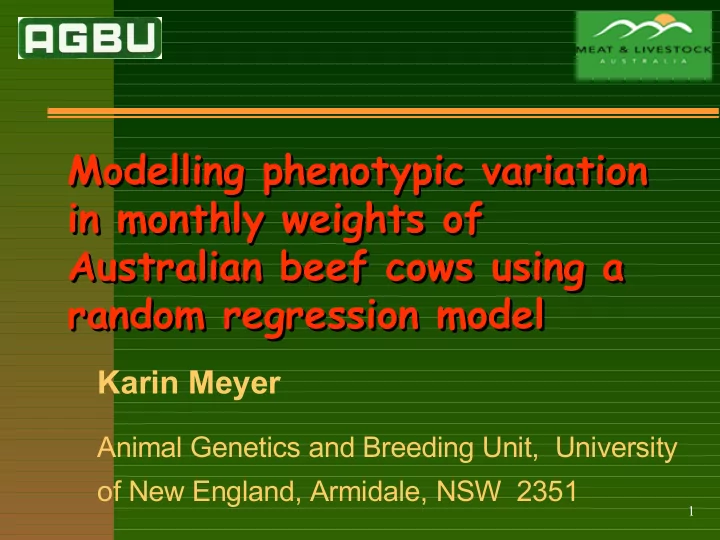

Modelling phenotypic variation Modelling phenotypic variation in monthly weights of in monthly weights of Australian beef cows using a Australian beef cows using a random regression model random regression model Karin Meyer Animal Genetics and Breeding Unit, University of New England, Armidale, NSW 2351 1
Random regression models to Random regression models to describe phenotypic variation in describe phenotypic variation in weights of beef cows when age weights of beef cows when age and season are confounded and season are confounded Karin Meyer Animal Genetics and Breeding Unit, University of New England, Armidale, NSW 2351 2
Random Regressions ■ Suitable for ‘repeated’ records ● continuous scale e.g. time ● allow for gradual & continual change of trait ■ Fit set of random regression coefficients for each animal ● replace single animal effect ● description of complete growth curve ■ Estimate ● Covariances(RR coefficients) Cov.Func. ● Measurement error variances 3
Data ■ Wokalup selection experiment ● 2 herds @ 300 cows; ✜ Polled Hereford (HEF) ✜ Wokalup (WOK) 4-breed synthetic ● selection for increased preweaning growth ● short mating period most calves born over 8 week period (April/May) ● monthly weighing of animals ✜ 87,516 weights, 1977-1990 ■ Select records on cows 19-84 months 4
Wokalup Research Station ~140km S of Perth
Wokalup Research Station ~140 km S of Perth
Climate at Wokalup Research station 1951-1996 Latitude 33.13 S, Longitude 115.88 E, Elevation 116m Mean annual rainfall 979 mm 250 35 Rain (mm) 200 Temp (C) 30 Temperature Rainfall (mm) 150 25 100 20 50 0 15 Jan Feb Mar Apr May Jun Jul Aug Sep Oct Nov Dec 7
Means & standard deviations : month Calving season
Distribution of ages over months J an Feb Mar Apr May J un J ul Aug Sep Oct Nov Dec 1000 750 500 Sep 250 M ay J an 0 9 24 39 54 69 19 29 34 44 49 59 64 74 79 84
Means & no.s of records : ages 10
Standard deviations for individual ages Origin al scale log scal e 11
Univariate analyses ■ Records for age i, i=19,84 ● consider ages i-1 , i and i+1 ■ Model ● animals, random ● year-week-paddock classes, fixed ● age, fixed ■ Estimate ● variance between animals ● error variance 12
Estimates : univariate analyses Betwe en animal s Tempo -rary envi- ronme nt 13
Random R Regression M Model (RRM) R ■ Fixed effects : ● year-week-paddock contemporary group ● fixed cubic regression on age (k=4) ■ Random effects : ● k random regression coefficients on orthogonal (Legendre) polynomials of age for each animal ✜ Sum of genetic & permanent environm. effects ● Temporary environmental effects 14
RRM analyses - 2 ■ Analyses by REML ● log likelihood (L) LRT ■ Estimate ● Covariance matrices of RR coefficients ✜ k(k+1)/2 parameters ● Measurement error variances ✜ me parameters ■ Calculate ● Covariance functions ● (Co)Variances for ages in the data 15
RRM : Standard deviations 16
RRM : Standard deviations -2 17
RRM : Estimates for different k k ( Legendre polynomials, me=1, Polled Hereford) 18
Measurement error variances ■ Reflect temporary environmental variation ■ Independently distributed ● homogeneous me=1 ● heterogeneous ✜ me=15 6 months intervals + separate σ 2 at extremes ✜ me=66 individual σ 2 for each age 19
Estimated standard deviations (kg) (Orthogonal polynomials; Polled Hereford) k=10 k=12 20
Estimated standard deviations (kg) (Orthogonal polynomials; Polled Hereford) k=14 k=20 21
Results : ME variances ■ Heterogeneous measurement error variances model data much better ● me=1 : log L = -90,747.7 k=20 ● me=66 : log L = -90,068.0 ■ Assumptions have little effect on estimates of between animal variances ● can compare models assuming homogeneous measurement error variances (me=1) provided order of fit is sufficiently large 22
Univariate vs . RRM analyses (Legendre poly. k=20, me=66) Betwe en animal s Tempo- rary environ -ment 23
Alternative curves ■ Use knowledge about periodicity of changes 12 months ■ Segmented quadratic polynomials (SQ) ● Spline function ● Avoid problems of high powers of age ● Choose knots carefully ■ Fourier series approximation (F) ● Sum of sin and cos functions ● Superimpose on LP to model age trend 24
RRM : Alternative curves (Polled Hereford, me=1) LP : Legendre Polyn. SQ : Segmented Quad. 25 F : Fourier Approx .
Conclusions ■ RRM capable of modelling complicated patterns of variation in longitudinal data ● large number of parameters required ● orthogonal polynomials work (no prior information on pattern of variation) ● alternative curves using known periodicity yield more parsimonious model ■ Future work : ● Genetic analyses ● Examine covariances & correlations 26
Estimated covariances for ages in data WOK SQ13F2 me=1 27
Recommend
More recommend